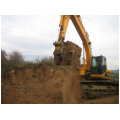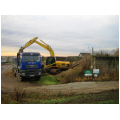Rock-Bed Environment
Rock-Bed Environment
Activities in remediation of rock-bed environment are frequent job orders in remediation division. Removal of contaminants from rock-bed environment in saturated and non-saturated zone is done by classic separation methods, which are effective in term/costs rate and also by special remediation procedures:
Venting
Venting involves vacuum extraction of contaminants where contaminated soil air is aspired form non-saturated zone via a suction station. It is the most used “in situ” remediation method of non-saturated zone. Venting is applicable for contamination by heavy organic compounds, chlorinated aliphatic hydrocarbons, chlorinated solvents, crude oil substances, PAU, quinones, phenols and phtalates.
Bioventing
This remediation technic lies in transport of oxygen into non-saturated zone by the forced pumping or air sucking from venting wells. That increases concentration of oxygen in non-saturated zone and improves conditions for biological decomposition of contaminants. Bioventing is used for organic pollution by crude oil hydrocarbons, PAU etc.
Biodegradation
When parameters for dangerous waste dumping are not met in DOC, preliminary treatment on biodegradation plants is secured. Biodegradation “in situ” can be implemented if conditions are suitable.
Soil Steaming and Leaching
This method stands on placement of suitable solution which can dissolve or change surface quality of pollutants in rock-bed environment. This leads to its fluidification or to disturbance of its sorptive structure with soil. Soil steaming and leaching can be done in situ or ex situ. It is used for crude oil hydrocarbons, volatile organic compounds, heavy metals, halogenated hydrocarbons, PAU, PCB and pesticides. Leaching is not suitable for combined contamination. In situ steaming and leaching is limited by character of rock-bed environment (permeability, heterogeneity etc.).







.jpg)


